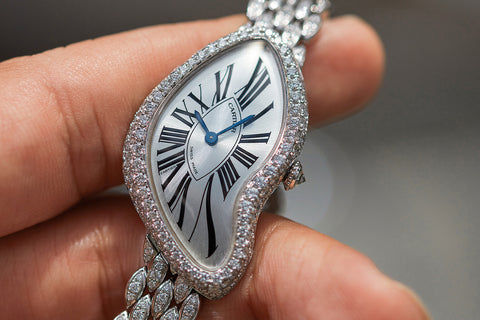Created by Louis Cartier in 1912, the Tortue was only Cartier’s third wristwatch design, after the Santos Dumont and Tonneau. With its unmistakable DNA and Cartier’s timeless style, the model's tortoise-inspired case quickly became a classic.
Beneath the curved crystal, a modern-style guilloché dial replaces the design of the original model from the 1920s, with the blued steel Breguet style hands and matching inky-blue minute track. An oversized "XII" numeral sits at 12 o'clock, with its dramatic proportions imbuing the design with a more contemporary feel. This is balanced by the "Cartier Paris" signature at 6 o'clock, which is also rendered in the same blue tone. Overall, the dial design blends the best of vintage Cartier, with bolder colours and proportions, combining the past and the present.
The Monopoussoir has a long and storied history at Cartier, with examples of the Tortue and Tank versions appearing in 1928 and 1935 respectively. During this time, Cartier worked closely with Jaeger to develop the movements behind these complicated timepieces. Years later, as part of the Collection Privée, Cartier collaborated with a group of talented watchmakers to bring it back to life. Flageollet and Journe worked on the project together, before Halter had joined THA Ébauche. Rather amusingly, Flageollet claims that it was the watchmakers who suggested to Cartier that they should recreate the design, as the people in charge at the time did not have an extensive knowledge of their archives or heritage.
This Cartier Tortue Monopoussoir makes use of the calibre 045MC, which uses a lever escapement, and can only be found in the various Tortue Monopoussoir made by Cartier, in addition to the Tank Monopoussoir and De Bethune Monopoussoir. With a clutch system, the motion of the second wheel to the chronograph’s central wheel is activated by a double swivel pin, removing the "jolt" of the seconds hand which often occurs in chronographs operated by a lateral clutch. The resulting operation allows the hand to smoothly glide across the dial.


























































































































































































































